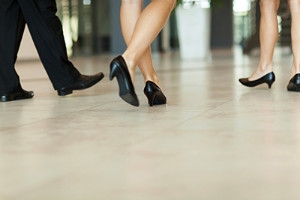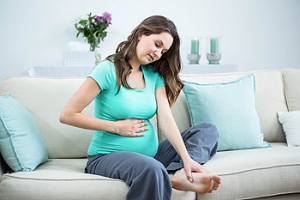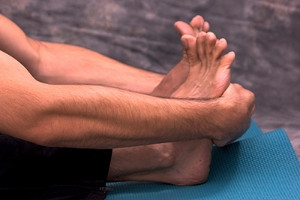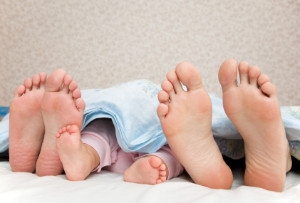

Wounds That Don't Heal Need to Be Checked
How to Protect Your Feet During the Work Day
 There are many people who spend the majority of their working day standing or walking. Research has indicated it is beneficial to wear shoes that fit properly, and this may help to prevent painful foot conditions from developing. It is helpful to make sure there is enough room for the toes to move freely in, and the feet will feel better when there is adequate cushioning and support. Resting the feet as frequently as possible may aid in reducing foot pain that comes from standing for extended periods of time. Additionally, it is important to choose shoes and socks that are made of breathable materials, as this can help to provide maximum comfort. Please consult with a podiatrist if you would like additional information about how to protect your feet while working.
There are many people who spend the majority of their working day standing or walking. Research has indicated it is beneficial to wear shoes that fit properly, and this may help to prevent painful foot conditions from developing. It is helpful to make sure there is enough room for the toes to move freely in, and the feet will feel better when there is adequate cushioning and support. Resting the feet as frequently as possible may aid in reducing foot pain that comes from standing for extended periods of time. Additionally, it is important to choose shoes and socks that are made of breathable materials, as this can help to provide maximum comfort. Please consult with a podiatrist if you would like additional information about how to protect your feet while working.
While working on the feet, it is important to take the proper care of them. For more information about working on your feet, contact Dr. Randy Garr from Bigfoot Podiatry. Our doctor will treat your foot and ankle needs.
Working on Your Feet
Standing on your feet for long periods of time can cause stress and pain in your feet. Your whole body may experience change in terms of posture, back pain, bunions, callouses and or plantar warts. There are ways to avoid these conditions with proper foot care, smart choices and correct posture.
Positive Changes
Negative heeled shoe – Choosing this shoe type places the heel slightly lower than the ball of the foot. These are great for overall foot health. Find shoes that fit you correctly.
Go barefoot – Our feet were not designed to be enclosed for all hours of the day. Try to periodically expose your feet to air.
Eliminate Pain
Foot Exercises – Performing simple exercises, incorporating yoga and doing stretches are beneficial. This will allow increased blood flow to the area and muscles of the foot.
Achilles tendon – Stretching the foot out flat on the floor will relax the calf muscles and tendon. These exercises can be performed almost anywhere. Make sure you add these exercises to your daily regimen.
With a little bit of this information and knowing more about foot health, you will notice changes. Foot stretches and proper footwear will help with pain and prevent further issues.
If you have any questions please feel free to contact our office located in Provo, UT . We offer the newest diagnostic and treatment technologies for all your foot and ankle needs.
How to Handle a Long Work Day on Your Feet
In 2014, the American Podiatric Medical Association surveyed 1,000 American adults and found that half of all respondents lived with foot pain. Fortunately, there are ways to avoid foot problems such as following a daily footcare routine and wearing proper footwear at work.
If you have a job that requires you to be on your feet, it is best that you do not wear flat sole shoes. Your heel should be slightly elevated (less than 2 inches, but at least ¼-inch) if you are going to be standing for a prolonged period. You should also make sure that the shoes you wear are not too small. Tight shoes may cut off circulation to your feet, which will result in pain and blisters. It is always best to purchase fitted shoes later in the day, because the feet tend to swell as the day progresses. It may also be helpful to buy shoes a half size larger if you plan on wearing custom orthotics or arch supports.
Your muscles may become stiff when you are constantly standing up. It is important to take breaks every hour to stretch and relax. One tip is to perform calf raises, because this exercise will help improve your circulation. To perform this stretch, you first need to stand on the edge of a step with your abdominal muscles pulled inward. You then need to grip the step with the balls of your feet with your heels hanging over the edge. Next, try to raise your heels above the step by a few inches while standing on your tiptoes; hold this pose for a second. You should then lower your heels back even to the platform. These calf raises should be done ten times for full effectiveness.
You should also take care of your feet while you are at home. One of the best ways to prepare your feet for a long day of work is to soak them in ice water. Doing so for 20 minutes will help fight the swelling and inflammation that results from being on your feet at work.
Nevertheless, if you are experiencing pain in your feet, you should seek help from your podiatrist. Your doctor will help treat any ailments you may have in addition to helping you prevent any other ailments from developing in the future.
Foot Changes That Can Occur in Pregnancy
 There are numerous changes a woman’s body goes through while being pregnant. The feet are often affected, and obvious differences can be noticed. These can include swelling, chronic aching, and muscle cramps. It is helpful to buy shoes that fit correctly, and the best time to accomplish this is later in the day when the feet are at their largest. It is important to choose shoes that have adequate room for the toes to move freely in, as this can help to prevent unwanted foot conditions from developing. When the feet become swollen, many women find mild relief when the feet are elevated, in addition to performing gentle foot stretches. If you would like additional information on how to have your feet feel better during pregnancy, please consult with a podiatrist.
There are numerous changes a woman’s body goes through while being pregnant. The feet are often affected, and obvious differences can be noticed. These can include swelling, chronic aching, and muscle cramps. It is helpful to buy shoes that fit correctly, and the best time to accomplish this is later in the day when the feet are at their largest. It is important to choose shoes that have adequate room for the toes to move freely in, as this can help to prevent unwanted foot conditions from developing. When the feet become swollen, many women find mild relief when the feet are elevated, in addition to performing gentle foot stretches. If you would like additional information on how to have your feet feel better during pregnancy, please consult with a podiatrist.
Pregnant women with swollen feet can be treated with a variety of different methods that are readily available. For more information about other cures for swollen feet during pregnancy, consult with Dr. Randy Garr from Bigfoot Podiatry. Our doctor will attend to all of your foot and ankle needs.
What Foot Problems Can Arise During Pregnancy?
One problem that can occur is overpronation, which occurs when the arch of the foot flattens and tends to roll inward. This can cause pain and discomfort in your heels while you’re walking or even just standing up, trying to support your baby.
Another problem is edema, or swelling in the extremities. This often affects the feet during pregnancy but tends to occur in the later stages.
How Can I Keep My Feet Healthy During Pregnancy?
- Wearing orthotics can provide extra support for the feet and help distribute weight evenly
- Minimize the amount of time spent walking barefoot
- Wear shoes with good arch support
- Wear shoes that allow for good circulation to the feet
- Elevate feet if you experience swelling
- Massage your feet
- Get regular, light exercise, such as walking, to promote blood circulation to the feet
If you have any questions please feel free to contact our office located in Provo, UT . We offer the newest diagnostic and treatment technologies for all your foot and ankle needs.
Pregnancy and Foot Health
Many pregnant women complain about foot pain while they are expecting. Foot pain can primarily be caused by weight gain and hormonal changes taking place in the body. By understanding how pregnancy impacts the health of a woman's feet, a pregnant woman can take action to keep her feet as healthy and comfortable as possible.
Because a woman's weight changes during pregnancy, more pressure is brought to bear on both the legs and the feet. This weight shift can cause two major foot problems: over-pronation, also known as flat feet, as well as edema, which is swelling of the feet. Over-pronation occurs when the arch of the foot flattens, causing the foot to roll inwards when the individual is walking, and can aggravate the plantar fascia tissues located along the bottom of the feet. If these tissues become inflamed, a pregnant woman can experience pain in the heel of the foot as well as severe foot pain while walking or standing. Swelling of the feet, or edema, often occurs in the later stages of pregnancy. It is caused by slow circulation and water retention, and may turn the feet a light purple color.
To keep feet in good health and prevent over-pronation, pregnant women should avoid walking barefoot and be sure they are wearing shoes that offer good arch support. A device known as an orthotic can be added to regular footwear in order to provide additional support for the feet during pregnancy. Any expectant mother whose feet hurt should first check to see if the shoes she is wearing are old, worn out and not offering the proper support necessary for distributing the weight of her body during pregnancy.
To treat edema of the feet, a good start is to wear quality footwear which offers support and good circulation. Keep feet elevated whenever possible by using a foot stool while seated. Stay well hydrated by drinking plenty of water to prevent water retention in the feet. Any swelling that occurs in only one foot should be examined as soon as possible by a doctor.
Good foot health during pregnancy can help expectant mothers avoid foot pain that leads to other health problems. Massaging the feet and doing regular gentle exercise like walking aids foot health by contributing to good circulation. Supportive shoes are also a good investment that will support foot health during pregnancy.
Stretching Techniques for the Feet
 When the soles of the feet are stretched, it may contribute to an overall positive feeling in the body. The feet are considered to be the foundation of the body, and chronic foot pain may affect the way you walk. There are simple ways to stretch the arches, toes, and soles, and it is beneficial to practice these stretches as frequently as possible. An effective stretch begins with starting on your hands and knees, and gradually sitting back on your heels, while keeping the toes tucked. To stretch the toes and ankles, sit on the floor and cross one leg over the other. Grasp one foot, and gently pull the toes apart, while moving the ankle in circles. The arch can be stretched by rolling the foot on a tennis ball or frozen water bottle. The latter technique may feel good after a long day of standing on your feet. If you would like additional information about how to stretch your feet, please consult with a podiatrist.
When the soles of the feet are stretched, it may contribute to an overall positive feeling in the body. The feet are considered to be the foundation of the body, and chronic foot pain may affect the way you walk. There are simple ways to stretch the arches, toes, and soles, and it is beneficial to practice these stretches as frequently as possible. An effective stretch begins with starting on your hands and knees, and gradually sitting back on your heels, while keeping the toes tucked. To stretch the toes and ankles, sit on the floor and cross one leg over the other. Grasp one foot, and gently pull the toes apart, while moving the ankle in circles. The arch can be stretched by rolling the foot on a tennis ball or frozen water bottle. The latter technique may feel good after a long day of standing on your feet. If you would like additional information about how to stretch your feet, please consult with a podiatrist.
Why Stretching Is Important for Your Feet
Stretching the feet is a great way to prevent injuries. If you have any concerns with your feet consult with Dr. Randy Garr from Bigfoot Podiatry. Our doctor will assess your condition and provide you with quality foot and ankle treatment.
Stretching the Feet
Stretching the muscles in the foot is an important part in any physical activity. Feet that are tight can lead to less flexibility and make you more prone to injury. One of the most common forms of foot pain, plantar fasciitis, can be stretched out to help ease the pain. Stretching can not only ease pain from plantar fasciitis but also prevent it as well. However, it is important to see a podiatrist first to determine if stretching is right for you. Podiatrists can also recommend other ways to stretch your feet. Once you know whether stretching is right for you, here are some excellent stretches you can do.
- Using a foam roller or any cylindrical object (a water bottle or soda can will do), roll the object under your foot back and forth. You should also exert pressure on the object. Be sure to do this to both feet for a minute. Do this exercise three times each.
- Similar to the previous exercise, take a ball, such as a tennis ball, and roll it under your foot while seated and exert pressure on it.
- Grab a resistance band or towel and take a seat. If you are using a towel, fold it length wise. Next put either one between the ball of your foot and heel and pull with both hands on each side towards you. Hold this for 15 seconds and then switch feet. Do this three times for each foot.
- Finally hold your big toe while crossing one leg over the other. Pull the toe towards you and hold for 15 seconds. Once again do this three times per foot.
It is best to go easy when first stretching your foot and work your way up. If your foot starts hurting, stop exercising to ice and rest the foot. It is advised that you then see a podiatrist for help.
If you have any questions, please feel free to contact our office located in Provo, UT . We offer the newest diagnostic and treatment technologies for all your foot care needs.
Stretching Your Feet
Debilitating foot pain is a problem for many people. But just as stretching the torso can help alleviate back pain, stretching the feet can also help mend existing foot problems and prevent future ones.
The feet, as the body’s foundation, carry the body’s entire weight and can get easily strained from overexertion. Persistent sharp pain and cramping in the feet are often common concerns. Foot pain and foot problems can be due to any number of causes, and in many cases pain may be eased without medication or doctor visits. It is always a good idea, however, to first rule out any serious medical issues with a physician.
Stretching can help relax the feet and alleviate pain, but is especially important before heavy aerobic exercise. Stretching before such activities can help you avoid experiencing painful cramps or strained foot muscles. Stretches should be performed slowly and deliberately without forceful pulling. The stretch should be held for several seconds before relaxing.
A great way to stretch out and loosen up the foot muscles while sitting is to cross one leg over the other and pull the toes carefully back without overextending. Start by resting the left ankle on the right knee. With the left hand, gently flex the left foot by pulling back on the toes. Do not pull too hard; just hard enough to feel the stretch in the arch of the foot. Then point the toes of the left foot as far as you can. Rotate the motion of pointing with pulling back on the toes. This should relax and stretch the muscles on the bottom and the top of the foot. Doing this stretch ten to twenty times should bring relief. Repeat the whole process for the other foot by resting the right ankle on the left knee.
A stretch that focuses on the often injured Achilles tendon involves standing and facing a wall with your arms out and hands flat against the wall. Step back with one foot, keeping it flat against the floor. Move the other leg forward and lean toward the wall. You should feel a stretch through the back of your leg and your Achilles tendon, but do not push yourself too much. Stop when you feel a stretching sensation, and hold for 30 seconds. Ten repetitions may be done for each foot.
Stretching the feet is important for athletes or those performing aerobic exercise, but it can also help anyone with foot pain caused by poor footwear, plantar fasciitis, or long hours standing and walking. Individuals who tend to their feet by regularly stretching every day should be able to minimize foot pain and prevent new problems from arising.
Babies and Flat Feet
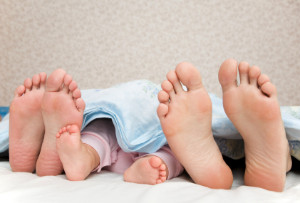 Research has indicated that most babies are born with flat feet, which will most likely change as they become older. This condition may persist in a limited amount of children, and there may be specific reasons for this. The Achilles tendon may be shortened, and this can result in the muscles and ligaments becoming tightened in the heel area. This can lead to reduced motion in the foot and may cause the arch of the foot to become flat. Children who have flat feet after walking begins may experience pain and discomfort in the place of the foot where the arch would normally be, and it may be difficult to move the foot up and down or side to side. If flat feet are left untreated, it can lead to serious foot conditions that may include arthritis. If you notice your child has flat feet while walking, it is suggested to consult with a podiatrist who can help you to find the correct treatment techniques.
Research has indicated that most babies are born with flat feet, which will most likely change as they become older. This condition may persist in a limited amount of children, and there may be specific reasons for this. The Achilles tendon may be shortened, and this can result in the muscles and ligaments becoming tightened in the heel area. This can lead to reduced motion in the foot and may cause the arch of the foot to become flat. Children who have flat feet after walking begins may experience pain and discomfort in the place of the foot where the arch would normally be, and it may be difficult to move the foot up and down or side to side. If flat feet are left untreated, it can lead to serious foot conditions that may include arthritis. If you notice your child has flat feet while walking, it is suggested to consult with a podiatrist who can help you to find the correct treatment techniques.
The health of a child’s feet is vital to their overall well-being. If you have any questions regarding foot health, contact Dr. Randy Garr of Bigfoot Podiatry. Our doctor can provide the care you need to keep you pain-free and on your feet.
Tips for Keeping Children's Feet Healthy
- Make sure their shoes fit properly
- Look for any signs of in-toeing or out-toeing
- Check to see if they have Clubfoot (condition that affects your child’s foot and ankle, twisting the heel and toes inward) which is one of the most common nonmajor birth defects.
- Lightly cover your baby’s feet (Tight covers may keep your baby from moving their feet freely, and could prevent normal development)
- Allow your toddler to go shoeless (Shoes can be restricting for a young child’s foot)
- Cut toenails straight across to avoid ingrown toenails
- Keep your child’s foot clean and dry
- Cover cuts and scrapes. Wash any scratches with soap and water and cover them with a bandage until they’ve healed.
If you have any questions, please feel free to contact our office located in Provo, UT . We offer the newest diagnostic and treatment technologies for all your foot care needs.
What to Do to Keep Your Child’s Feet Healthy
Being a parent involves caring for your child in every way you can. You make sure they are eating the right food, being nice to others, and staying out of any trouble. However, it is also important that you are watchful of their health, more specifically their foot health. Maintaining good foot health in childhood is important in preventing later conditions in life from happening. As children continue to develop, their feet require different techniques of care. Here are some various ways in which you can help your child’s feet stay healthy.
A baby needs a lot of care and attention overall, but the importance of their feet should never be forgotten. Before a baby turns one, their feet change and develop greatly. It is important that during this time, a mother avoids putting tight socks on their child. She should also encourage movement of their feet so the baby can begin to feel more comfortable using them.
As a baby enters the toddler years of his or her life, they are begin to walk around. When your baby begins to take those first steps, it is crucial that they are wearing protective shoes on their feet. As a mother that is observant of your child’s feet, you may notice changes in them. This is completely normal as the feet are becoming susceptible to the activity of walking. It is normal for a toddler to be a bit unsteady or to “walk funny” at first.
When your child grows out of their toddler years, it is important that you begin to show him or her how to care for their feet on their own. Practice with your child proper hygiene in order to prevent foot fungus or infection. Since children are constantly on the move, it is crucial to be cautious of any accidents or injuries that might occur. If an injury occurs, it is advised that you take your child to be examined by a doctor immediately. Since your child is still growing, particular injuries can shift the way in which a bone or other important part of the foot is developing.
Babies and kids are always changing and growing. Your job as a parent is to make sure they stay healthy and making sure they are properly maintained. This involves proper foot care and making sure the feet stay healthy. Following this guide, your child can live a long and happy life.






